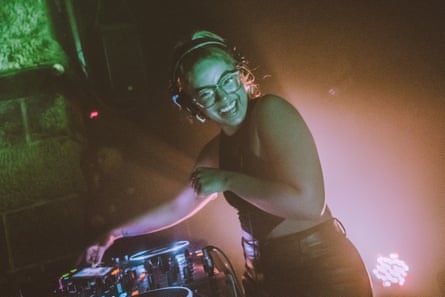Thursday night at Glastonbury was pure brown joy. South Asians at the festival’s Lonely Hearts Club stage exchanged knowing looks of shock and elation as Sbtrkt closed his set with a track rarely heard outside Spotify playlists: Jai Paul’s Str8 Outta Mumbai. The crowd had barely settled from the high energy tablas when London-based south Asian DJ Jyoty took the stage with banger after banger: a highlight was hearing British Asian pop star Jay Sean, as well as an Afrobeats mix of classic Hindi hit Bheegi Bheegi Raaton Mein which she prefaced: “Where my brown people at?” One punter, Rahul, described it as “life-affirming”.
This was just the beginning of this year’s south Asian offering, which has grown at Glastonbury in the past couple of years to make the festival one of the leading champions of the British Asian dance underground. In 2022, there was a thrilling takeover by dance music collective Daytimers and back-to-back sets by Yung Singh, Ahadadream and Manara; the latter three featured in this year’s lineup too, with multiple shows.
DJ Bobby Friction, who has been bringing bhangra to the Somerset festival since 1998, hosted a Going South takeover where he platformed a number of south Asian DJs, old and new. When asked why this music seems to be having its moment, Friction put it down to global audiences embracing the sound, regardless of language barriers. “At my Glastonbury show this year I came out with the Bhangra singer Bee2, who was like Hendrix on the [single-string instrument] tumbi, a load of Punjabi dancers, and we had thousands of white people, who have probably never heard bhangra, losing their shit.” He continues: “I think, like reggae, its time has come to be part of global culture.”
South Asian creative movement Dialled In threw a secret party in the Shangri-La area. Lit up with green lights, it was alive with their trademark concoction of sounds from the native and diaspora community, including the south Asian underground: club edits, R&B, Afrobeats, Punjabi garage, Bollywood samples and bassy techno. Dialled In team member Almass Badat said she felt “absolutely elated and full of inspiration” after the event. “To provide a sonic playground for DJs of south Asian heritage to play back-to-back created a moment we’ve never experienced in this way before. I feel empowered to be given the programming space with full creative trust,” she said.
A newcomer to this year’s lineup was DJ Priya, AKA “Thee Bass Baddie”. “I can’t describe my sound without describing the energy that I bring when I play it, which – and I mean this humbly – is unmatched. People have asked me if there are trampolines under the decks because of how much time I spend jumping around,” she said. The DJ from Southall, London, was trained by Jyoty, and had the Glastonbury crowds jumping with her. Talking about the importance of south Asian representation in the lineup, she said: “For so long we have been portrayed negatively in the media, we’ve been the butt of the joke, the unpopular kids, or if you did see anyone who was Asian in music, most of the time it would be a man.
“I rarely saw someone that looked or sounded like me, not just in music but in the media in general. I made it my mission to show up as the person I needed to see when I was younger, and I’m so glad that other Asians are being booked and representing themselves, too. It’s not just about ticking boxes any more, most of us are being recognised for our talent.”

The Australian artist Surusinghe was also at Glastonbury this year, playing four times across the festival. She describes her sound as “lots of drums and bass but not drum’n’bass” and stresses the importance of the south Asian music community. “I owe it all to artists such as Ahadadream who have put me forward for so many slots and opportunities. It’s so nice to feel supported by other south Asian artists – that’s what gives me the confidence to keep growing.”
This year also saw the first south Asian meet-up which Friction organised through social media. Dozens of brown faces came together under the Ribbon Tower, asking “Is this the south Asian thing?” followed by warm embraces and excitable chatter. Vinay, who is 68, told me how he first came to Glastonbury in 1984 when entry cost £13; 41-year-old Kirrin Punia, dressed in a purple bodysuit, said: “When I hear south Asian music played in clubs, it’s amazing, it’s liberating, it’s like: ‘Welcome to my world’”.
Badat said she hopes to see south Asian artists on Glastonbury’s Pyramid stage – something that could be coming in 2024. Friction recently had a meeting with Glastonbury co-organiser Emily Eavis, and in his words: “She said let’s do something big next year.” Looking at the joyful faces of all ethnicities during the weekend’s south Asian DJ sets, it’s clear that there’s the audience for it.

